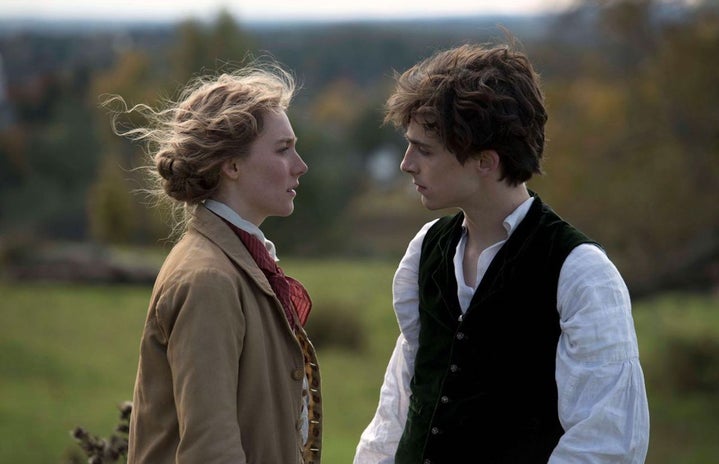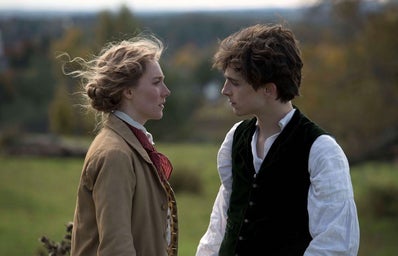Exploring Gerwig’s adaptation of a beloved tale of girlhood
Be warned, this piece contains spoilers!
I love Greta Gerwig’s Little Women. It’s the first film I mention whenever someone needs a recommendation, the first film I suggest when my family is deciding what to watch (to which they groan because they are truly tired of hearing it), and the only film that is always on my Netflix’s currently watching list.
First on the endless list of reasons I love this film is the cinematography. Akin to a warm hug: we are enveloped into a dream-like world which exudes cosiness and familiarity. The childhood scenes are laced with a palpable sense of nostalgia. The colour-grading mimics the rose-tinted glasses we view our childhood memories with; everything was bigger, richer, and more beautiful. This is a stark contrast to the aesthetic of adulthood that is painted, with darker colours and a more realistic tone.
Gerwig weaves intricate details through costume choices. Throughout the film, Laurie and Jo are seen wearing each other’s clothes which highlights them being, as Gerwig puts it, ‘androgynous halves of the same being’. For example, the vest Laurie is wearing when Jo jokingly proposes to him and gives him a ring – is the same one that Jo is wearing when Laurie proposes to her in the scene on the hill. It’s details such as these that add to the richness of the film. There are countless more, which I bet you wouldn’t notice, even after watching it as many times as I have!
A fascinating dynamic unfolds between Jo and Amy, both driven by insatiable ambition: however, while Jo achieves her goal of becoming an author and owning her own book, Amy (who dreams of becoming a painter) considers herself a ‘failure’. When she speaks to Laurie in Paris – she says she wants to be ‘great or nothing’ and that while she may be talented, ‘talent isn’t genius’. Throughout the film, we see Amy in a constant turmoil of self-comparison to Jo. When Laurie tells Amy to marry him instead of Fred Vaughn – she simply replies ‘I have been second to Jo my whole life, and I will not be the person you settle for just because you cannot have her’. Even when Amy burns her sister’s book, she is doubtful that she could do anything to undermine Jo. As Gerwig describes it, she’s like ‘but what could me burning your book do to you? You’re Jo; you’re magical!’
Gerwig says in an interview for IndieWire, that while re-reading the book before shooting the film, she realised that Amy was a much greater character than traditionally perceived – always pitted against our heroine Jo and often favoured the least. Gerwig’s genius lies in painting a more sympathetic portrayal of Amy than previous adaptations, garnering a newfound popularity for Amy. Reflecting on this later in the interview, Gerwig says, ‘what an interesting diagnosis of our culture that the character who says most clearly what she wants is the one that we hated for so long’.
Gerwig also discusses Laurie as being the first male character who immerses himself in a female space. As girls growing up, we get a lot of practice imagining ourselves into the spaces of the opposite gender (for example as pirates or kings); boys have less experience. We see this for ourselves in the film, where the sisters, dressed in suspenders and top hats as British men, act out their ‘club’. When Laurie arrives, he radiates a sense of belonging within this family of girls – a family that is the antithesis of the one he has experienced. The March family is consistently shown throughout the film to have brought colour and fun into Laurie’s otherwise empty life. We see this in the scene where the family all come to the Laurence family house to get Amy after she is hit at school by her teacher. The large house is overwhelmingly quiet and filled with this sense of emptiness, yet when the girls enter, a flurry of excitement and laughter ensues, emphasised as they leave the scene again, and it is just Mr Brooke, Laurie, and his grandfather left in the room in an awkward silence.
The film’s cyclical nature is encapsulated in its opening and closing scenes. At the beginning, we see Jo start trying to sell her story to publishers, and at the end we see Jo leave the publishing house with her own book in hand. Gerwig emphasises the significance of this as the final scene: ‘it’s not girl gets boy, it’s girl gets book’. Jo achieves her main goal which was not to be married or to find love, it was to achieve her dream of owning her own book, defying societal expectations.
Throughout the film, Gerwig’s masterful use of parallels and cyclicity is powerful; I notice more and more details every time I watch the film! The use of the March family home as the main setting throughout the film also ensures that there are so many of these parallels. We see these characters sit in the very same spots in their home as adults that they once sat in as children. Through her use of the setting, Gerwig creates a sense of familiarity – everything in the film feels as though we’ve seen it somewhere before, which we often have: in an earlier scene.
Overall, the film’s charm lies in its reflections on growing up, juxtaposing childhood innocence with the challenge of adulthood. ‘We could never have loved the earth had we had no childhood in it – what novelty is worth that sweet monotony where everything is known and loved because it is known’. This passage that Jo reads to Beth from George Elliot’s book, ‘The Mill on the Floss’, for me, serves as an explanation for why Little Women is such a comfort film. We watch these four small girls with hope and ambition experience childhood and become women – and most of it happens in the same setting: their childhood home. We see ourselves in its characters, whether it’s Jo with her dreams of being a writer, or Meg’s of being a mother. We see our own childhoods in theirs, from Jo crying after impulsively getting all her hair cut off, to Amy’s jealousy and childish infatuation with Laurie; and in their trials of heartache, loneliness and grief, we see our own.


